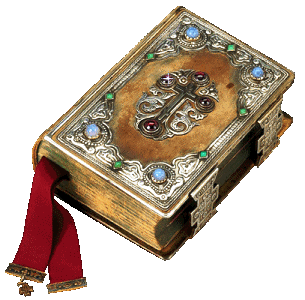
The Divine Liturgy is a process. It is a process which has as its purpose and end the encounter with God and the union of man with God. As we said in our previous Homilies, this goal has been achieved. We have reached the end of our course. We saw the true Light, Christ. We followed in the footsteps of His holy life. We worshiped him in the Cave of Bethlehem, as he was born of a Virgin, during the proskomide. With the Small Entrance of the Holy Gospel we saw Jesus enter into the world to begin His world-saving work. By listening to the Gospel, we hear each time His authentic teaching and we witness His Miracles and the details of His life. With the Great Entrance of the Holy Gifts we accompanied the Lord on His way to Golgotha. We became friends with Jesus and His twelve disciples at the Last Supper. We witnessed His bloodless sacrifice and Him changing our humble Gifts into the Holy Body and Blood of Christ through the action of the Holy Spirit.We saw His Resurrection and proclaimed it with the prayer: "Seeing the Resurrection of Christ ..." We shared His holy Body and His Most Valuable Blood. And now the Mother Church comes to remind us that the end of our liturgical process must be the starting point of our witness.
"Let us go in peace", recites the Celebrant.
We must take leave of the Last Supper and go back to the world and walk the path of martyrdom. And this path that takes place in the peace of God, becomes the testimony of the believer for the Way that Christ has set for man and the truly blessed life.
During the Divine Liturgy we received Christ, the peace of God. Now we are called by our behavior to convey it to the world. To show in practice what is the true Christian life, which Christ pointed out, and which ensures true happiness in man.
After Holy Communion we go out into the world enlightened, enlivened, Christ-bearing (that is, we carry Christ in us). We must now strive to keep the light of Christ we have received alive, so that the gifts we have received may also be active in the souls of our brothers who are not serving the Liturgy.
The Prayer behind the Ambon which is read by the Priest outside the Altar. (It is called the Payer behind the Ambon because in the old days tje Ambon was located in the center of the temple and the priest read the prayer behindtit).
"Let us pray to the Lord", the Deacon exclaims. After the "Lord have mercy" of the people, we hear the well-known Prayer behind the Ambon: "Lord, Who blesses those who bless You… save Your people…". The prayer is said in favor of the people of God, whom it calls the assembly of the Church of Christ, which lives in this world.
Saint Hippolytus writes: The world is the sea on which the Church sails as a ship that is moved but does not sink. Because it is moved by Christ. It bears the Cross of the Lord as a trophy of victory over death. It has the two rudders0, the Old and New Testaments. It is wrapped all around with strong ropes, that is, the love of Christ that protects the Church. The Holy Spirit is the sail on the mast. As sailors he has Angels on the left and right, with whom the Church is protected and guarded. Passengers are all baptized Christians. These are the assembly mentioned in the Prayer behind the Ambon and to which the Priest is bound. And what does he ask for? Since we ask for the mercy of the Lord, without us having anything of our own to offer to be saved, but because we put our trust in the Grace of Him Who is the only one who can save us.
Also with the Prayer in question we seek to live a sanctified life in a peaceful world. Special mention is made of those persons who love the beauty of the holy Church and work hard for it. And in fact it is added for them: "Glorify them in return by Your divine power...". From this we all learn that the cleanliness of the church, the order and the decency, reveal the reverence of the faithful towards God and His holy House, as well as contribute to the glorification and praise of the Triune God!
The Divine Liturgy began with repeated prayers for the acquisition in our hearts and in the world of peace. This peace we ask for is the peace of Christ, which He transmitted to His Disciples after His Resurrection. The Celebrant now comes and reminds us of this with a sentence from the final dismissal: "Let us go in peace". This presupposes that we also have a duty to make every effort to have a peaceful day.
My dear brothers and sisters, those who try to maintain the sacred emotions they felt during the Divine Liturgy and after the Divine Liturgy, ccontinue the Liturgy after the Divine Liturgy and enjoy the spiritual joy by the Divine Grace. Thus the Divine Liturgy is not an event inoö our everyday life, but the life-giving source of power that gives inspiration and vision to our lives. Amen.





